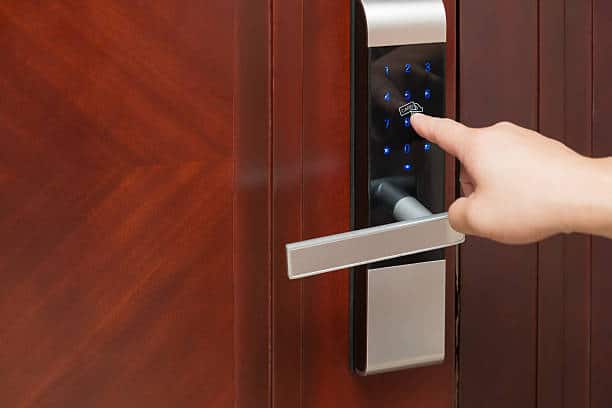Convenience and security go hand in hand in the fast-paced world of today. One of the most innovative advancements in home and vehicle security is the keyless entry system. The days of misplacing keys or being anxious about losing them are long gone. With this system, you can effortlessly unlock doors and start your car with just a push of a button or a simple touch.
A keyless entry system is a way of going into and controlling a car, home or building without the traditional physical key. Instead of putting a key in the lock, by entering numbers on the keypad, use the remote control or enter within range while carrying some designated key fob or smartphone that has a proximity sensor which then unlocks automatically.
In this comprehensive guide, we will explore the world of keyless entry systems:
- How Do Keyless Entry Systems Work?
- Advantages of Keyless Entry System
- Types Of Keyless Entry Systems
- Installation and Compatibility
- Features and Customization Options
- Keyless Entry System Security and Safety
- Maintenance and Troubleshooting
- Brands and Options
How do Keyless Entry Systems Work?
It utilizes advanced technology to provide a secure and convenient way to access your home or vehicle. Instead of traditional keys, these systems use electronic signals to authenticate and grant access. The most common types of keyless entry systems rely on either a keypad, a remote control, or biometric identification.
Keypad-based keyless entry systems require you to enter a unique code on a numeric keypad to unlock the door. Once the correct code is entered, the system verifies it and grants access. Remote-based systems, on the other hand, use a handheld device, often called a key fob, to send a signal to the receiver in the car or home. When the signal is received, the system verifies its authenticity and unlocks the door. Biometric keyless entry systems use your unique physical characteristics, such as fingerprints or iris patterns, to grant access. These systems provide an additional layer of security by ensuring that only authorized individuals can gain entry.
Advantages
Keyless entry systems offer numerous advantages over traditional lock and key systems. Firstly, they provide convenience and ease of use. No more searching for keys in your bag or pocket, especially when your hands are full. With this system, you can simply enter a code, press a button, or use your biometrics to unlock doors or start your car. This saves time and eliminates the frustration of misplaced or lost keys.
Secondly, keyless entry systems enhance security. Traditional keys can be easily duplicated, increasing the risk of unauthorized access. However, utilizes encrypted codes and signals, making it extremely difficult for intruders to bypass the system. Additionally, some keyless entry systems offer features such as remote monitoring and alert notifications, providing an added layer of protection for your home or vehicle.
Another advantage of keyless entry systems is their versatility. They can be easily integrated into existing doors and vehicles, ensuring compatibility and ease of installation. Moreover, these systems often come with customizable features, allowing you to tailor them to your specific needs and preferences.
Types of Keyless Entry Systems – Keypad, Remote, and Biometric
Keyless entry systems come in plenty of varieties these days. The most common ones include keypad-based, remote-based, and biometric systems.
- Keypad-Based: Keypad-based systems require you to enter a unique code on a numeric keypad to gain access. Both household and commercial settings frequently use these systems. They offer a convenient and keyless way to secure your property. Keypad codes can be easily changed, providing flexibility and enhanced security.
- Remote-Based: Remote-based systems, also known as key fobs, use a handheld device to send a signal to the receiver in the car or home. These systems are widely used in the automotive industry and offer the convenience of unlocking doors or starting the car from a distance. Remote-based keyless entry systems often come with additional features such as trunk release and panic buttons.
- Biometric: Biometric keyless entry systems utilize your unique physical characteristics, such as fingerprints or iris patterns, to grant access. These systems provide a high level of security, as biometric data is difficult to replicate. Biometric keyless entry systems are commonly found in high-security environments, such as government buildings and research facilities.
Installation and Compatibility
Installing a keyless entry system may seem daunting, but it can be relatively straightforward with the right knowledge and tools. Before purchasing a keyless entry system, it is important to ensure compatibility with your existing doors or vehicle. Different systems may have specific requirements or limitations, so it’s essential to read the manufacturer’s instructions and specifications carefully.
For keypad-based systems, installation typically involves mounting the keypad near the door and connecting it to the control unit. Remote-based systems require programming the key fob to communicate with the receiver in the car or home. Biometric systems may involve additional steps, such as registering fingerprints or iris patterns in the system’s database.
If you need more confidence in your DIY skills, it is recommended to hire a professional locksmith or technician to install the keyless entry system for you. They have the expertise and experience to ensure a proper installation and can guide you on compatibility issues.
Features and Customization Options
A variety of features and customization choices are available with keyless entry systems to accommodate different demands and tastes. Some common features include:
- Multiple User Codes: Keypad-based systems often allow the programming of multiple user codes, making it convenient for family members or employees to access the premises without sharing a single code. This feature also allows temporary codes to be assigned to guests or service providers.
- Remote Start: Many remote-based keyless entry systems offer a remote start feature, allowing you to start your vehicle’s engine from a distance. This is particularly useful in extreme weather conditions, as it allows the car to warm up or cool down before you enter.
- Integration with Home Automation Systems: Some keyless entry systems can be integrated with home automation systems, enabling you to control not only your doors but also other smart devices in your home. This integration allows for seamless control and monitoring of your entire smart home ecosystem.
- Time-Based Access Control: Certain keyless entry systems offer the ability to set time-based access control. This allows you to restrict access to certain individuals or groups during specific periods, enhancing security and flexibility.
Keyless Entry System Security and Safety
When it comes to security and safety, keyless entry systems have made significant advancements compared to traditional lock and key systems. These systems utilize encryption technology and rolling codes to prevent unauthorized access. Rolling codes generate a unique code each time the system is activated, making it virtually impossible for hackers or intruders to replicate the code.
Additionally, some keyless entry systems offer advanced security features such as intrusion detection, tamper alerts, and remote monitoring. These features provide an extra layer of protection and allow you to be notified of any suspicious activity or attempted breaches.
While it enhances security, it is important to remember that no system is completely foolproof. It is recommended to regularly update the system’s firmware or software to ensure you have the latest security patches. Furthermore, it’s important to follow good security practices such as not sharing access codes or leaving key fobs in plain sight.
In terms of safety, these systems often come with emergency features such as panic buttons or distress signals. These features can be crucial in emergencies, allowing you to quickly call for help or alert authorities.
Maintenance and Troubleshooting
Regular maintenance is essential to ensure the longevity and optimal performance of your keyless entry system. Here are several tips for maintenance to remember:
- Keep the System Clean: Clean the keypad, key fob, or biometric scanner regularly to remove dirt, dust, or any other debris that may hinder their functionality.
- Check the Batteries: Replace the batteries in your key fob or keypad as needed. Weak batteries can cause the system to malfunction or lose power. Some popular brands in the industry include:
- Test the System: Periodically test the system to ensure it is functioning properly. This includes testing all features, such as locking and unlocking doors, starting the vehicle, and verifying biometric recognition.
- Follow Manufacturer’s Guidelines: Always refer to the manufacturer’s guidelines and instructions for specific maintenance requirements and troubleshooting tips.
If you encounter any issues with your keyless entry system, troubleshooting can often resolve the problem. Some common troubleshooting steps include checking battery connections, reprogramming the system, or resetting the system to factory settings. If the issue persists, it is recommended to contact the manufacturer’s customer support or consult a professional technician.
Brands and Options
The market for keyless entry systems is vast, with numerous brands offering a wide range of options. Several well-known brands in the market are:
- Schlage: Schlage is a well-known brand that offers a variety of keyless entry systems, including keypad-based and smart lock systems. They are known for their durability, security features, and compatibility with home automation systems.
- Kwikset: Kwikset is another reputable brand that specializes in keyless entry systems. They offer a range of options, including keypad-based, remote-based, and biometric systems. Kwikset is known for its user-friendly interface and innovative features.
- Yale: Yale is a trusted brand that provides advanced keyless entry systems. They offer a range of options, including keypad-based, remote-based, and biometric systems. Yale is known for its high-quality products and cutting-edge technology.
When choosing a keyless entry system, it’s important to consider factors such as your specific requirements, budget, and compatibility with existing doors or vehicles. Reading customer reviews and seeking recommendations can also help make an informed decision.
Conclusion
Keyless entry systems have revolutionized the way we secure our homes and vehicles, providing convenience, security, and peace of mind. With its advanced technology and customizable features, it offers a wide range of options to suit different needs and preferences. As technology continues to evolve, we can expect keyless entry systems to become even more sophisticated, integrating seamlessly with smart home automation systems and offering enhanced security features.
The future of keyless entry systems looks promising, with continued advancements in biometric identification, artificial intelligence, and connectivity. We can anticipate further integration with voice recognition technology and mobile apps, allowing for seamless control and access management. With the ongoing focus on convenience and security, keyless entry systems are poised to unlock a future where traditional keys are a thing of the past.
Frequently Asked Questions
1. Are keyless entry systems secure?
It utilizes advanced encryption technology and rolling codes to provide a high level of security. However, it is important to follow good security practices such as regularly updating firmware, not sharing access codes, and keeping key fobs secure.
2. Can keyless entry systems be installed in older homes?
Yes, it can be installed in older homes. However, compatibility may vary depending on the type of system and the existing door hardware. It is recommended to consult a professional locksmith or technician for guidance.
3. Can keyless entry systems be hacked?
While no system is completely immune to hacking, keyless entry systems use encryption technology and rolling codes to make it extremely difficult for hackers to gain unauthorized access. Following good security practices can further minimize the risk of hacking.
4. Can I still use a traditional key with a keyless entry system?
Most of this still provides an option to use a traditional key as a backup. This allows you to maintain access in case of system failure or battery depletion.


